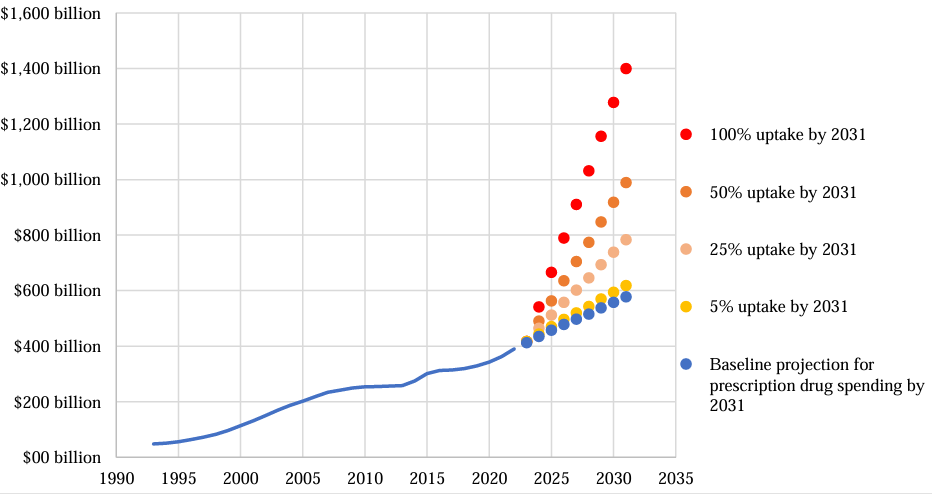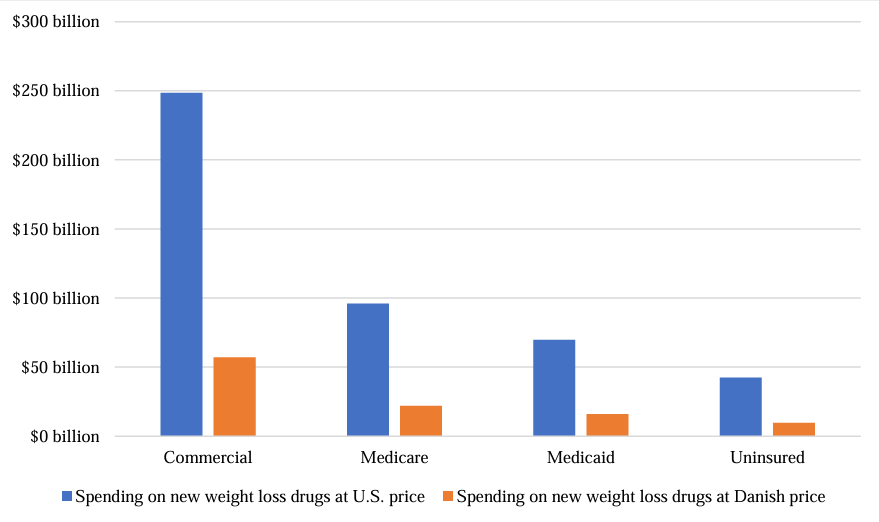By now, most people have heard of GLP-1s, such as Ozempic and Wegovy, the drugs that aid in weight loss and have recently gained recognition for their cardiovascular benefits, including reducing the risk of major adverse cardiovascular events like heart attack, stroke, or death. The constant theme in the news surrounding these drugs is not only their popularity but also the question of price, particularly, ‘Who is paying for all of this?”
In May 2024, the Health, Education, Labor and Pensions Senate Committee released a report titled, ‘How Weight Loss Drugs Could Bankrupt American Health Care’.1 It’s a striking title that some might find exaggerated; however, the numbers speak for themselves. The report highlights a KFF poll showing that nearly half of all American adults are interested in taking weight loss drugs.2 That’s approximately 135 million individuals. To understand the pricing impact, we can examine the current U.S. cost for the two popular weight loss drugs, Ozempic and Wegovy.
While these are list prices (what one might pay out-of-pocket or with no insurance coverage), someone is bearing the cost (be it patient or payor). The Senate Committee extrapolated from these values that if 50% of Americans started taking these drugs, it would cost upwards of $411 billion per year—more than what all Americans spent on all retail prescription drugs in 2022 ($406 billion)1 Of that, Medicare and Medicaid would spend approximately $166 billion annually on weight loss drugs, almost surpassing total spending on all retail prescription drugs in 2022 ($175 billion). The Committee found that unless prices declined, these weight loss drugs could cause Americans to spend over $1 trillion per year on prescription drugs. The table below shows the estimated baseline prescription drug spending and how the uptake of these weight loss drugs may impact annual spending by 2031.

The CEO of Novo Nordisk, the maker of Wegovy, will testify before the committee that delivered this report in early September 2024.
The prices paid for these drugs in the U.S. are different from those in other countries. While other countries determine pricing through government cost-effectiveness assessments, capitations, price ceilings, and various federal negotiations, in the U.S. prices can be freely set by the drug manufacturer. Additionally, the prices individuals pay result from complex processes involving various stakeholders like PBMs, employers, and insurers. Here is a pricing breakdown of what these weight loss drugs cost in the U.S. versus other countries.
| Price by Country (monthly) | Ozempic | Wegovy |
| U.S. | $969 | $1,349 |
| Denmark | $125 | $186 |
| Germany | $59 | $92 |
The Committee’s report modeled (Figure 2) how, if the U.S. were charged the same as Denmark (where Novo Nordisk is headquartered), the savings for the health system would be drastic. Essentially, the U.S. health system would save roughly $300 billion per year, estimating a 50% uptake of these drugs by U.S. adults.

An interesting solution some have proposed to the U.S. pricing dilemma is that Medicare should simply purchase the Wegovy manufacturer Novo Nordisk. In an opinion column in STATNews, the authors describe (somewhat tongue-in-cheek) that at a market cap value of ~$600B for Novo Nordisk, the costs of the acquisition compared to Medicare paying for increased weight loss drug spending ‘would be recouped in 22 months through GLP-1 purchases alone.’4 While it is unlikely that Medicare will start acquiring drug manufacturers to offset prescription drug spending increases, the fact that this solution is considered cost-saving compared to the current situation highlights the conundrum payors are facing.
Despite the significant cost impact, more payors are allowing access to these drugs. Take North Carolina, for example, where it was announced on July 17th that NC Medicaid would start covering obesity drugs in August 2024.5 Interestingly, as pointed out by STATNews, “this comes after North Carolina decided to stop covering obesity drugs for its state employees due to the high costs”.6 The weight loss drugs resulted in $100 million in spending in 2023 for NC (10% of all prescription drug spending).
As the uptake of these drugs continues and more individuals seek them, either for weight loss or new indications such as cardiovascular health, discussions around their cost will continue to make headlines. This comes at a time when new drugs, such as gene therapies—some of which are breaking records for the ‘most expensive drug of all time‘—are being introduced to the market. How the payment debates will be settled is anyone’s guess, but this situation provides an exciting case study on how pharmaceutical innovation meeting unprecedented demand impacts those within the value chain differently.